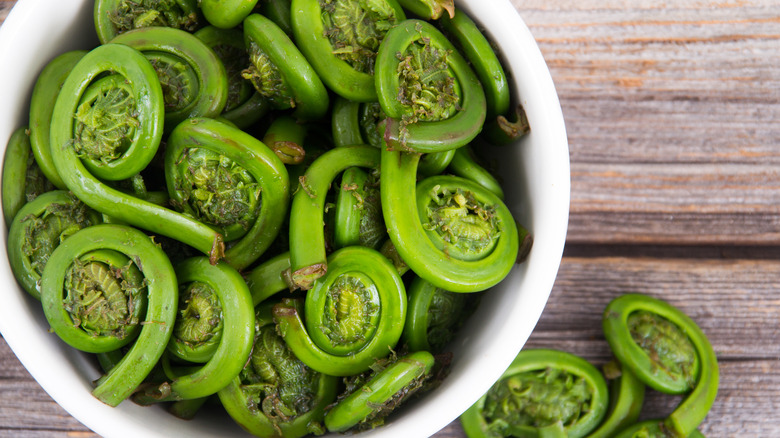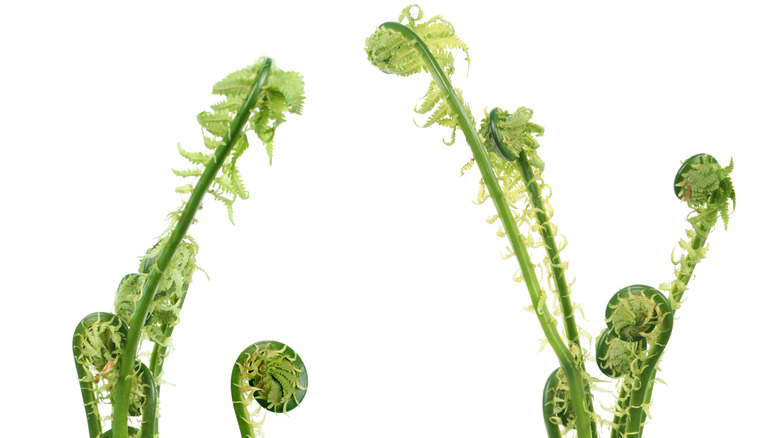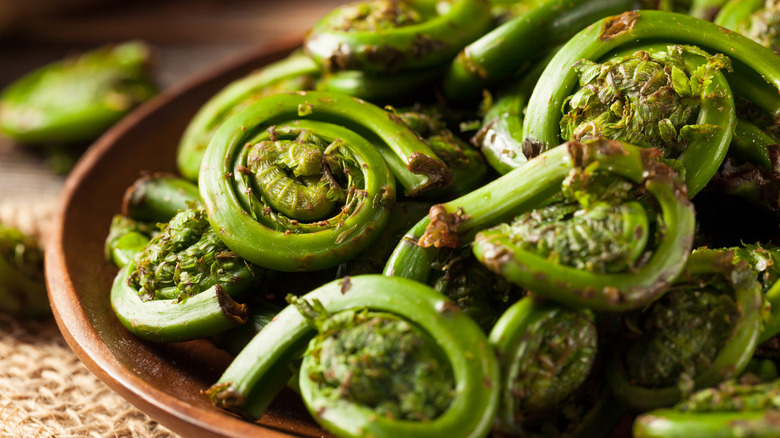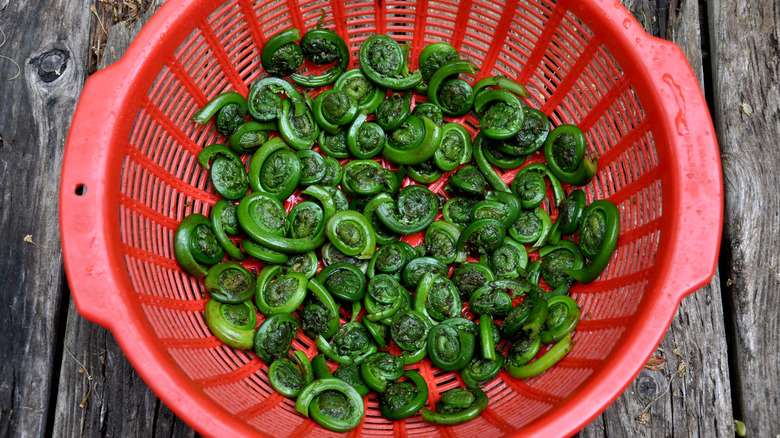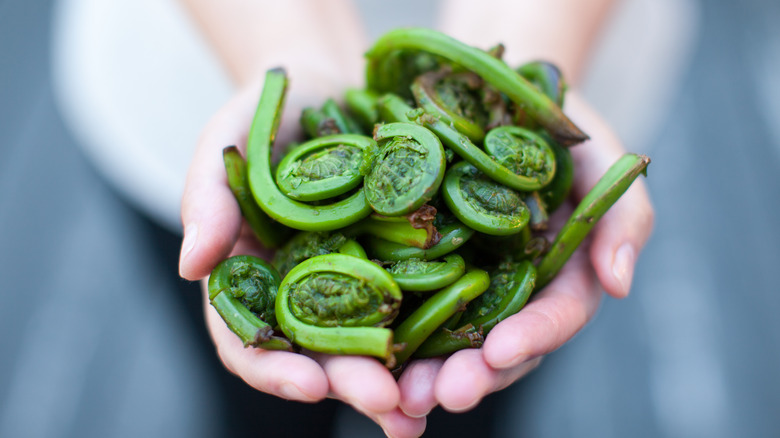What Are Fiddleheads And What Do They Taste Like?
You may or may not have heard of fiddleheads, a funny-sounding name for an edible type of plant that, for those who eat them, are simply irresistible. Whether or not you've heard the name but don't know much about fiddleheads or where they come from, you can now learn everything you need to know about what might be your new favorite ingredient.
Fiddleheads are also known as fiddlehead ferns, though they don't resemble your typical fern plant. The bits known as the fiddleheads (the parts you eat) are small spirals or coils of newly growing ferns. Fiddleheads are found and enjoyed seasonally — in the spring when the ferns are in their prime growing season — and get their name from their resemblance to the spiraled head of a fiddle or violin. Aside from their use in cooking and unique taste, fiddleheads also contain a lot of vitamins and fiber (via Farmers' Almanac).
Where do fiddleheads come from?
Fiddleheads don't just come from any kind of fern, though there are a few different varieties. The most common kind of fiddlehead comes from a plant called the ostrich fern or (Matteuccia struthiopteris) which is the most commonly eaten type in North America. Ostrich ferns can be found growing in more northern regions of North America, including Canada and New England, but other types of ferns that produce similar fiddleheads can be found across the globe, according to Farmers' Almanac.
Surprisingly, fiddleheads are one of the few very popular ingredients that are still widely foraged in natural areas (via Fearless Eating). Oftentimes, you can find fiddleheads in forests and along rivers, where they thrive in the wild (be sure to bring a guide to avoid possible toxic plants). If you're hiking in the woods of northern North America, there's a good chance you could spot growing in clumps of six popping out from the soil and twigs. Of course, because fiddleheads are a popular spring snack and ingredient, you can also pretty easily find them at stores and markets.
What do fiddleheads taste like?
Fiddleheads have a grassy and nutty flavor and a crispy texture. Not sure what to expect? They are sort of like a mash-up of artichokes, asparagus, mushrooms, spinach, and green beans. A fiddlehead is essentially a perfect combination of all the best-tasting vegetables. You can imagine why they are so popular, especially in spring-centric recipes, given their green color and natural flavor. Plus, they're arguably some of the most interesting and fun-looking vegetables that make it seem a-okay to play with your food.
It's also understandable, given their coveted flavor and texture and all the "good stuff" coiled up inside of them, that fiddleheads are actually considered superfoods. After all, if all the best vegetables are wound up into one delightful spiral, that makes getting your vitamins and daily dose of vegetables pretty easy, per Farmers' Almanac. They contain antioxidants, potassium, iron, vitamin A, and fiber. And while fiddleheads have their own unique flavor, they do taste especially good when lightly cooked, but not raw or overdone.
You should always avoid consuming fiddleheads raw because they're quite bitter and actually contain a small amount of potentially harmful toxin, according to Northern New England Poison Center. A pinch of heat and a little seasoning goes a long way with these delectable fern sprouts.
How to prepare and cook fiddleheads
Fiddleheads don't need a ton of preparation. Some thorough rinsing with cold water should do the trick, whether or not you foraged them yourself or bought them from a store.
To reiterate, fiddleheads don't need to be overly seasoned since they have a tasty natural flavor. Popular ways to cook fiddleheads include boiling them, sautéeing them, or steaming them, but you'll want to avoid overcooking them so they don't lose their flavor and crunch. They tend to pair well with butter and lemon and a light seasoning of salt and pepper. It's common to sauté fiddleheads with unsalted butter, sea salt, garlic, or shallots.
If you're still pretty new to preparing and cooking fiddleheads, don't fret; most sources suggest approaching fiddlehead cooking the way you would asparagus, as they have very similar flavors, textures, and seasonal pairings, per Martha Stewart. In the site's recipe, the fiddleheads are steamed for just four minutes until tender before they are sautéed with butter for two minutes until golden. All told, fiddleheads will lose their texture and brightness if cooked longer than that.
Where to find fiddleheads
As mentioned, fiddleheads are the kind of versatile vegetable that can be both foraged and also found in grocery stores and farmers' markets. If you're foraging, be sure you are well-researched on the proper techniques of foraging and aware of any potentially dangerous or hazardous plants and animals.
If purchasing fiddleheads, know that because their growing season is very limited, they are highly coveted and can be hard to find, especially as the spring season comes to an end. Your best chances of finding fiddleheads will be around early-to-mid-April and through May. When browsing your store's selection of fiddleheads, there are a couple of things to keep in mind to make sure you're grabbing the best of the bunch.
According to Food52, you'll want to look for the fiddleheads that are tightly coiled and still bright green in color. If it looks as if the fiddlehead has unfurled quite a bit or is brown in color, opt for another. Take note that some fiddleheads have a papery brown outer leaflike coating that's a result of natural growth, and when rubbed off or removed, can expose a perfectly healthy and bright green fiddlehead underneath. You'll also want to make sure the fiddlehead is firm to the touch and not squishy and giving way to the slightest pressure.
How to store fiddleheads
In addition to their short season, fiddleheads also don't last very long once picked, harvested, or bought. You'll want to consume them pretty shortly after bringing them home and washing them thoroughly. Keeping fiddleheads too long without cooking or enjoying them will cause them to lose their unique, sought-after flavor. Food52 suggests that, if you can't cook your fiddleheads immediately upon bringing them home and have to store them, wrap them tightly in plastic wrap and keep them well refrigerated. You should try to use them within a few days.
Unfortunately, fiddleheads are not great for freezing as they'll lose their flavor and signature crunch upon thawing. However, a possible loophole for keeping fiddleheads for longer than the typical timeframe is to consider pickling them. They will obviously adopt the strong flavor of your preferred pickling method, but their own flavor and texture should still shine a little bit upon eating.
